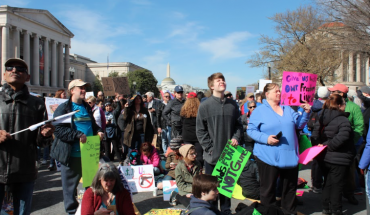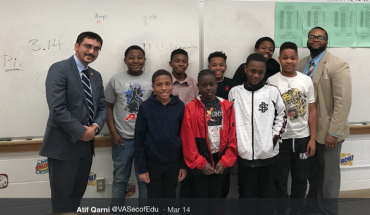By Fourth Estate Editorial Board
Alyssa Alhadeff
Martin Duque Anguiano
Nicholas Dworet
Jaime Guttenberg
Luke Hoyer
Cara Loughran
Gina Montalto
Joaquin Oliver
Alaina Petty
Meadow Pollack
Helena Ramsay
Alexander Schachte
Carmen Schentrup
Peter Wang
Christopher Hixon
Aaron Feis
Scott Beigel
Fourteen students and three faculty members attended school on Valentine’s Day and never made it back home. CNN reported it was the eighth school shooting in 2018. We are only halfway through February. The students of Marjory Stoneman Douglas High School have spent the following days not just grieving, but vocalizing that this would not have happened without the 19-year-old’s legal access to an AR-15. During a rally on Saturday in Fort Lauderdale, Fla., MSDHS senior Emma Gonzalez exclaimed, “Politicians who sit in their gilded house and senate seats funded by the NRA telling us nothing could have been done to prevent this, we call BS!”
Fourth Estate stands with the students and their assertions that America has a gun problem that the government must address with action.
CNN’s Kara Fox compiled “How US gun culture compares with the world in five charts,” while we recommend this article be read in its entirety, some red flags marking our gun problem include that “the U.S. makes up less than 5 percent of the world’s population, but holds 31 percent of global mass shooters,” and that “Americans own the most guns per person in the world.” The U.S. holds the number one position in the world for mass shootings.
Fox cites Australia as an example of how gun law reform helped eliminate mass shootings. After 35 people died and 18 were seriously wounded in a 1996 mass shooting with a “military-style semi-automatic rifle,” CNN’s Laura Smith-Spark reported in 2015 that zero mass shootings have occured after the Australian government banned rapid-fire rifles and shotguns, improved gun owner licensing and “collected and destroyed more than a million firearms.” Australia also reduced the risk of gunshot fatalities by 50 percent.
While addressing politicians in general, Gonzalez specifically called out President Trump for receiving $30 million from the National Rifle Association in campaign donations. The Center for Responsive Politics proves this to be true – “The NRA’s largest 2016 outlay was the $30.3 million it spent in support of Trump,” with a total of $50.3 million that was donated to Trump and six Senate candidates.
In a tweet prior to Gonzalez’ speech, Trump directed attention to the shooter’s mental health,
“So many signs that the Florida shooter was mentally disturbed, even expelled from school for bad and erratic behavior. Neighbors and classmates knew he was a big problem. Must always report such instances to authorities, again and again!”
And he placed blame on the Democratic party, tweeting:
“Just like they don’t want to solve the DACA problem, why didn’t the Democrats pass gun control legislation when they had both the House & Senate during the Obama Administration. Because they didn’t want to, and now they just talk!”
However, the Obama administration created a regulation to make it more difficult for some people with mental illnesses to obtain guns. Specifically, according to ABC News, people who received mental health benefits would have their names entered into the National Instant Criminal Background Check System. It did not go into effect until Dec. 2017. On Feb. 28, 2017, President Trump signed H.J. Res 40 into law, a bill that repealed the regulation.
And yes, Gonzalez mentions this contradiction in her speech.
Directing the conversation solely to mental illness further stigmatizes mental illness, including people who live every day without a violent thought. Many of us either are or know friends, family members and peers who have depression, attention-deficit hyperactivity disorder, or autism – three conditions the MSDHS shooter had, according to the New York Times. We know that none of these conditions alone would push a person to committing mass-murder. The real problem is that violent people are accessing firearms with mass-shooting capabilities too easily.
One commonality we do see in mass shooters is that they are typically perpetrators of domestic violence. According to the New York Times, the MSDHS shooter had a history of violence against a woman — more specifically his ex-girlfriend. What does this teach us about the connection between toxic masculinity and mass murders? Toxic masculinity describes certain traditional male roles that society creates to harm people. That society creates this idea that men with guns are ‘desirable’ or more ‘masculine,’ according to Harper’s Bazaar.
The Sutherland Springs church shooter, who killed 26 people during a service, is an example of this. The shooter had a history of domestic violence against his ex-wife and stepson.
Another example was in 2014, the Santa Barbara shooter wrote a 137 page manifesto condemning women who rejected him before he completed his rampage. This culture can give these men the impression that they have ownership of women’s lives and their bodies. These are examples of deeply rooted toxicity that bolsters the misogynistic culture this society creates. So while we must address the gun problem, we should also examine the pervasiveness of domestic violence that many mass shooters committed beforehand.
Gun enthusiasts must ask themselves: is our right to bear arms worth stepping on the rights of children to safely attend school (17 killed, MSDHS; 26 killed, Sandy Hook; 32 killed, Virginia Tech), the rights of LGBTQ people to safely enjoy a night out (49 killed, Pulse Nightclub), or the rights of music lovers to safely attend a festival (58 killed, Harvest Music Festival)?
While this is the eighth school shooting this year, the MSDHS students are making sure this will be the last, and that it will not be forgotten. They are doing something remarkable – directly addressing politicians on camera, on twitter and on the news. Gonzalez made a strong, resonating speech but she is not alone. We are witnesses to the traumatizing footage they shared online, the devastating screenshots of what could have been their last words with their loved ones. They’re reigning in the full power of social media by staying on top of timelines and even organizing a protest – March For Our Lives, taking place on March 24 in Washington, DC.
MSDHS students, consider us marching along with you.



